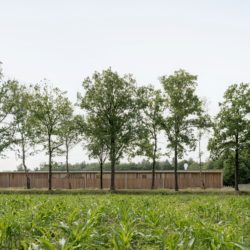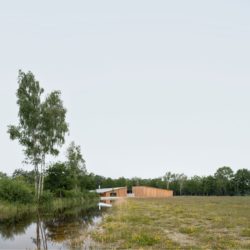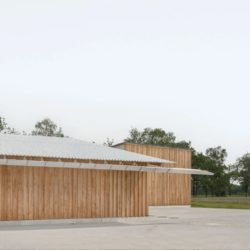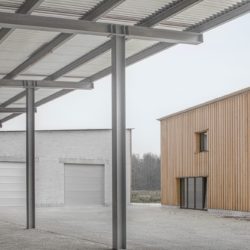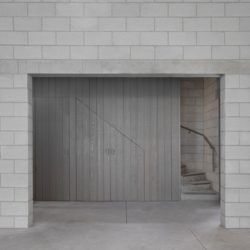
Studio Jan Vermeulen . Tom Thys Architecten . photos: © Jeroen Verrecht
Studio Jan Vermeulen i.c.w. Tom Thys Architecten has completed a new sustainable visitor centre for Prinsenpark in Retie, a unique landscape park in the Kempen north of Antwerp.
The project brings together the park’s administrative offices, its forestry depot and workshops, and visitor facilities in a new settlement of two refined timber buildings.
Large pitched roofs with long V-shaped gutters define the identity of the project that meets Passive-House standards and demonstrates circular construction methods.
Royal, sustainable and wild
Studio Jan Vermeulen in collaboration with Tom Thys architects developed a masterplan for the main entrance landscape infrastructure and designed a new visitor centre that replaces the outdated existing buildings of Prinsenpark.
Prinsenpark is a landscape park in the Kempen nord of Antwerp. Originally set up in 1880 as the grounds for a royal estate that was never build, the park has developed into a unique reserve with a clear focus on providing access to nature and education. In 2021 the park has won an international Green Flag Award for its ‘sustainable vision, fine facilities and its broad range of educational activities’. Prinsenpark’s unique identity has been developed over 140 years and is defined by the strong combination of the original royal formal park structure and its wild flora.
The park nestles itself as a precise and defined figure in the landscape. An oval pathway circumnavigates the central forest with its formal structure of meandering paths and trails that provide access to the park. Extension to these woods sometimes merge with the surrounding landscape, sometimes they provide contrast. This creates an intriguing bocage landscape around the oval forest in which open and closed vistas alternate.
A picturesque ensemble
The new centre brings together the parks’ administrative offices, its forestry depot and workshops, and visitor facilities in an ensemble of two buildings with pitched roofs. In between the Kastelse Dike that cuts the landscape in a long straight line, and the edge of the oval woods, two volumes define an enclosed space that serves as a yard for the foresters. Large pitched roofs overhang to create an entrance, a covered outdoor space or a protected work area.
Reminiscent of the 18th century experimental farmsteads that were developed in this area to cultivate this former peatland, the buildings specific geometry generates a variety of silhouettes. As in a picturesque ensemble the relation of the project with its surrounding landscape is multi-layered. An aspect that is reinforced by new pathways, clearances, channels and rainwater retention areas that anchor the project in a natural way.
Enfilade
The first building, the visitor centre, comprises the visitor facilities, offices, canteen and changing areas for the parks’ staff. The second building contains the depots and workshops for the foresters. An allegory of the royal but wild landscape of Prinsenpark, the new project combines elements of the local building culture with the formal plan of a country house.
The visitor centre has been set up as an enfilade of rooms and halls under a large pitched roof that overhangs towards the oval woods. A succession of large rooms and smaller in between spaces allows for a varied use in which different spaces can contain different activities. Large window and door openings connect the information desk, the reception area and the education room with the offices, the staff canteen, and the central yard, and make the operational activities of Prinsenpark visible for the visitors.
A refined casco structure
The timber clad buildings have a rural expression but precise detailing around windows, gutters and gates transcend the utilitarian. The identity of the project is defined by the rhythm of lightly abraded Larch boards that wrap around the volumes as a rain and windscreen. The roof structure with its untreated aluminium corrugated panels and exceptionally large V-shaped gutters provide the project more refinement.
The rooms and halls are constructed with white concrete blocks and beams forming a robust and neutral background for the parks’ activities. Constructed within a low budget, the project is an intelligent and flexible structure where the building elements closer to the user get more detail and refinement. Timber clad light weight walls, custom made doors and windows, and fixed furniture, stained in deep blue, green and purple colours subtly contrast with the concrete blocks and bring hierarchy to the enfilade.
The depot and workshops are combined in an L-shaped building that encloses the central yard. A series of galvanized steel porticos define a flexible covered space for the storage of forestry equipment.
A balanced ecosystem
In various ways the project focuses on integrated sustainability. The large roof overhang of the visitor centre not only creates a social space for visitors, but also serves as passive sun protection for the large spaces along its main facade.
The construction assembly methods of various building elements allow for easy disassembly, re-use or recycling. In that respect, the building acts as a sustainable materials bank for the future. The visitor centre also meets the passive house standard.
Water management is used as an educational element and connects the project and the landscape in a new ecosystem. The existing channels and ditches were adapted into wadis to create a water and infiltration landscape where new fauna and flora can flourish. As such the site’s biodiversity receives a new impulse. Rainwater is collected in tanks and ponds via long V-shaped gutters and spouts before overflowing into the system of natural landscaped retention areas. The trajectory of the water is visible to the visitor. The wastewater is filtered and purified by an independent system before being returned as clean water to the landscape.
Various housing options have been integrated into the facade of the workshops to accommodate the local bat population. The building contributes to the values and vision of Prinsenpark as an area where nature, culture and recreation are interwoven into a special and balanced ecosystem.
_




